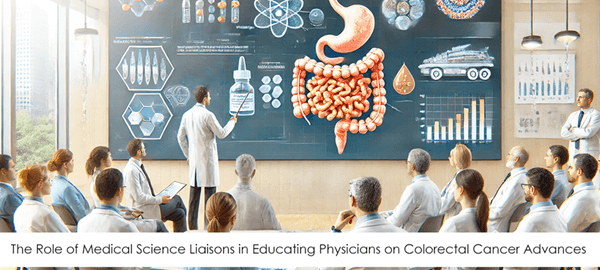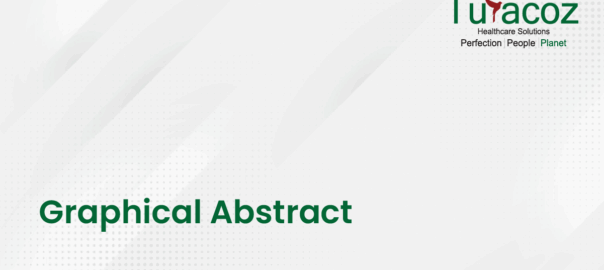Colorectal cancer (CRC) is the third most commonly diagnosed form of cancer globally and is the second most common cancer-related cause of death worldwide.1,2 This makes CRC a major public health issue due to the great economic burden it places on countries. There is significant progress in screening, diagnosis, and therapy for CRC at present; however, prognosis is poor, and there are challenges.2 With rapid advancements in treatment, staying updated on new therapeutic developments is crucial. Medical Science Liaisons (MSLs) play a vital role in bridging the gap between pharmaceutical companies and healthcare professionals (HCPs) by providing scientific expertise, facilitating medical education, and ensuring the exchange of accurate, up-to-date clinical data and therapeutic guidelines.3
The growing importance of MSLs in oncology
MSLs are highly trained scientific professionals, often with advanced degrees in medicine, pharmacy, or life sciences, and are key members of the medical Affairs teams of pharmaceutical companies.3 They serve as a critical link between the pharmaceutical industry and the medical community, aiding in informed decision-making, fostering collaborations, and enhancing patient care.4
In oncology, where the treatment landscape evolves rapidly, MSLs play a key role in equipping physicians with the knowledge necessary to optimize patient care.
How MSLs keep physicians updated on CRC research
Colorectal cancer treatment has witnessed major advancements in recent years, including targeted therapies, immunotherapies, precision medicine and biomarker-based treatment, antibody-drug conjugate therapy, and novel chemotherapy.5 MSLs ensure that physicians stay informed on these innovations in the following ways:
- Providing clinical insights
MSLs interpret and communicate complex clinical trial data, helping physicians understand the latest scientific breakthroughs and how new therapies compare with existing treatments in terms of efficacy, safety, and patient outcomes.6 Thus, MSLs serve as a bridge between the industry and HCPs or key opinion leaders (KOLs), facilitating a two-way exchange of scientific and clinical information. By keeping KOLs informed about the latest industry developments, MSLs help save their valuable time.4
- Explaining mechanisms of action
With the rise of precision medicine, understanding the molecular mechanisms of novel drugs is crucial. MSLs educate physicians on how therapies, such as immune checkpoint inhibitors, monoclonal antibodies, and combination regimen, work at a molecular level.
- Navigating treatment guidelines
Organizations like the National Comprehensive Cancer Network (NCCN) and the American Society of Clinical Oncology (ASCO) frequently update treatment guidelines. MSLs assist physicians in integrating these changes into clinical practice, ensuring adherence to the most recent guidelines.
- Facilitating real-world data insights
Beyond clinical trials, real-world evidence plays a crucial role in assessing long-term treatment effectiveness and improving medical treatment.7 MSLs provide valuable insights into patient responses, adverse event management, and emerging real-world trends.
How MSLs bridge research and clinical practice
One of the major challenges in oncology is translating scientific research into practical, patient-centered care. MSLs address this challenge by:
- Conducting peer-to-peer educational programs
MSLs organize advisory boards, roundtable discussions, and one-on-one meetings with KOLs to discuss recent advancements in the therapeutic area and their implications for clinical practice. MSLs gather insights from KOLs and help in guiding research and product development for pharmaceutical and biotechnology companies.
- Facilitating clinical trials
Oncologists often collaborate with pharmaceutical companies to enroll patients in clinical trials. MSLs help identify suitable studies, clarify eligibility criteria, and provide trial-related updates to oncologists.
- Providing medical education resources
From whitepapers to webinars, MSLs curate educational content tailored to the needs of oncologists, ensuring they have access to reliable and relevant information.
- Fostering multidisciplinary collaboration in CRC treatment
Colorectal cancer management requires a multidisciplinary approach, involving medical specialists such as medical oncologists, surgical oncologists, radiologists, gastroenterologists, radiation oncologists, and pathologists.8 MSLs play a crucial role in fostering collaboration among these specialties by:
- Encouraging interdisciplinary discussions on treatment sequencing and combination strategies.
- Addressing concerns related to emerging therapies, such as side effect management and patient selection criteria.
- Ensuring consistent communication between pharmaceutical companies and medical institutions to align treatment advancements with real-world patient needs.
Call to action: Recognizing the impact of MSLs in oncology
The Colorectal Cancer Awareness Month serves as a timely reminder to recognize and appreciate the invaluable contributions of MSLs in the fight against CRC. Turacoz proudly acknowledges and values the critical role MSLs play in advancing care and driving impact in the battle against CRC. Their expertise not only advances physician education but also enhances patient outcomes by ensuring that the latest medical innovations are seamlessly integrated into clinical practice.
By championing the role of MSLs, we can bridge the gap between research and real-world care, ensuring every patient with CRC receives the best treatment possible.
References
- Klimeck L, Heisser T, Hoffmeister M, et al. Colorectal cancer: A health and economic problem. Best Practice & Research Clinical Gastroenterology. 2023 Oct 1;66:101839.
- Fadlallah H, El Masri J, Fakhereddine H, et al. Colorectal cancer: Recent advances in management and treatment. World journal of clinical oncology. 2024 Sep 24;15(9):1136.
- Chen J, Burns G, Kelly C, Vanderhoef D, Johnson J. Medical Science Liaisons: A Guide for Advanced Practice Registered Nurses. The Journal for Nurse Practitioners. 2024 Nov 1;20(10):105211.
- García García C, Riosalido Montero M, Sastre V, González del Castillo A, Matesanz Marín A. The medical science liaison role in Spain: Opinion of the commercial department personnel. Therapeutic Innovation & Regulatory Science. 2023 Sep;57(5):1030-9.
- Alese OB, Wu C, Chapin WJ, et al. Update on emerging therapies for advanced colorectal cancer. American Society of Clinical Oncology Educational Book. 2023 May;43:e389574.
- Theron P, Britland M, Holder D, Ikeda Y, Rewers RF, Tiku A. Promoting best practices for medical science liaisons position statement from the APPA, IFAPP, MAPS and MSLS. Therapeutic Innovation & Regulatory Science. 2021 Nov;55:1139-44.
- Moss B, Goodall EA, Maravic Z, et al. Real-world evidence research in metastatic colorectal cancer: raising awareness of the need for patient contributions. Future Oncology. 2023 Aug 1;19(26):1811-23.
- Sievers CK, Kratz JD, Zurbriggen LD, et al. The multidisciplinary management of colorectal cancer: present and future paradigms. Clinics in colon and rectal surgery. 2016 Sep;29(03):232-8.


